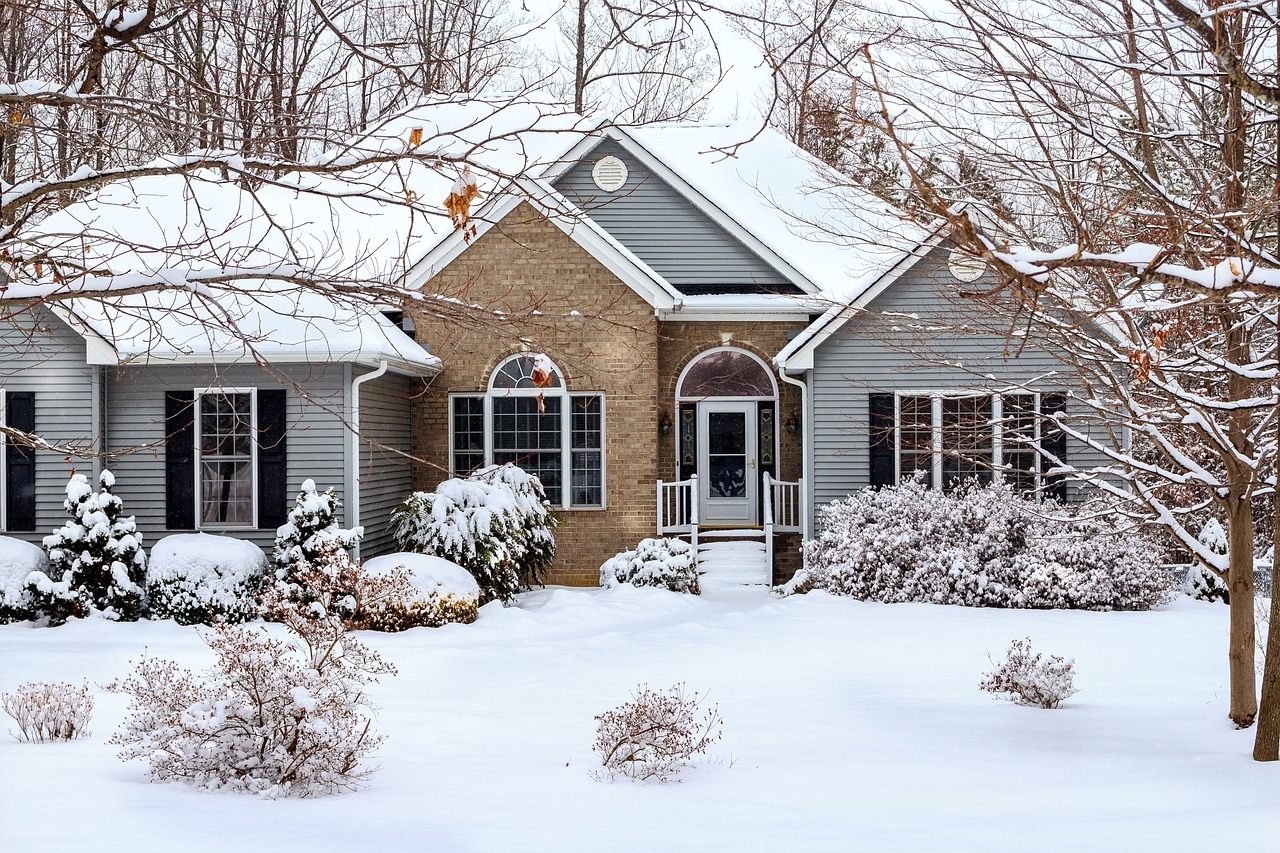Your siding, like your roof, plays a key role in the overall protection of your home. Not to mention it adds significant curb appeal and can even raise the overall value of your home. With that in mind, proper siding maintenance can increase its longevity and save you from a full siding replacement for years to come.
Siding Materials
The first part of siding maintenance is to know what kind of material your siding is made out of. It’s important because each material is different and cleaning it might require specific methods. The three main materials you will encounter in mid-Missouri are vinyl, wood, and stone. For more information about those specific materials, pros and cons, and replacement options, click here.
Vinyl Siding Maintenance
Vinyl siding is the most popular type of siding in the United States. This is because it requires relatively little maintenance, lasts for a long time, and doesn’t have many of the cons that other materials might have.
Trimming Trees & Bushes
One of the big benefits of vinyl siding is that it doesn’t rot or wear like wood siding does. However, it can crack or puncture. The best way to keep your siding crack and puncture free is to maintain the trees and shrubs that might come into contact with the siding. Trimming your trees and bushes can prevent accidental damage to the siding and increase its longevity.
In the event that your siding does become cracked, it may need to be replaced. But, you don’t always have to replace all of the siding on the house – you may just need to replace that one section. Another easy way to keep your vinyl siding in tip-top shape is to clean it.
How often you should clean your siding depends on the manufacturer’s recommendations. A good rule of thumb for cleaning vinyl siding is to clean the sides that experience more shade once a year and to clean the sunnier sides of the home every 3-5 years.
Cleaning
Cleaning vinyl siding is incredibly easy because of the construction of the material. We recommend using a 50/50 mixture of household soap (like dish soap) and water. Spray down the siding with your mixture and scrub any exceptionally dirty areas with a stiff bristle brush. Once you are done scrubbing, spray off the siding with a garden hose. If soap doesn’t do the trick you can use a 50/50 bleach and water mixture.
The color in vinyl siding is actually part of the manufacturing process. The color is “baked” into the core material and so it should never fade. Typically if you think your siding color is fading, it just means it’s time for a good cleaning. If you want to change the color of your siding it can be painted. However, our siding installation experts DO NOT RECOMMEND that you paint your siding. A paint job won’t harm the siding and it only takes about 2 coats to cover the color of the vinyl. But, you will find yourself having to paint the siding fairly often which increases the cost of upkeep.
To find out more about vinyl siding, how it’s made, and the benefits of it, click here.
Stone Siding Maintenance
Stone siding is known for adding quite a bit of curb appeal to a home. In fact, many people consider it one of the most positive ROI (return on investment) home improvement projects that you can do.
Sealants
Once of the main reasons why people like stone siding is for the natural rustic look. If your siding is natural stone, the most important part of maintaining it is ensuring that the sealant stays strong. The sealant helps the stone stay in place and weather anything mother nature can throw at it. What type of sealant you should use will depend on the stone composition. We recommend contacting the manufacturer to ensure you’re using the right sealant.
Cleaning
The only other part of natural stone siding maintenance is an occasional spray down. Normally a garden hose will do the trick. If you need to use a cleaning spray only use natural cleaners. Any sort of cleaners that contain acid and other chemicals could ruin the stone and cause a whole lot of headaches.
Not all stone siding is natural stone. In fact, many siding manufacturers have switched to manufactured stone veneer. Manufactured stone veneer looks exactly like stone – and even feels like it. But, it’s more cost effective and doesn’t require any mining.
Cleaning stone veneer is extremely easy. Because this type of surface is specifically designed with durable materials, a simple hose down once or twice a year will keep this siding in excellent condition. If you have spots that have some moss or “stains” on them. A simple 50/50 dish soap/water mixture should do the job. Be sure to check manufacturer recommendations if you want to use chemicals to clean the stone veneer.
Wood Siding Maintenance
Most wood siding, specifically in the United States, is made of cedar. Cedar wood siding can bring a lot of character to a home. But, because it is a natural material and more prone to decay and rot, it requires a lot more maintenance than vinyl or stone.
Sealers
Sealers are a good start. Depending on the sealant that is already on the siding (if the siding is not new) your options may be kind of limited. There are 3 different types of sealant. The first one is the most common: paint. The paint helps protect the wood from moisture and prevent the wood from absorbing too much water. Typically wood siding should be repainted every 5 years or so. The easiest way to tell if your siding needs to be repainted is to look for chips or cracks in the paint.
The second type of sealant is a stain. Stain actually soaks into the wood – which is how it seals the wood. However, because it soaks into the wood, it’s hard to change the color of the siding once it has been stained a specific color.
The last form of sealant is a clear sealer. These types of sealants work similar to paint, but allow the natural color and pattern of the wood to be visible. Clear sealants don’t last as long as paint and typically need to be reapplied every 2 years. One of the benefits of clear sealers is that they are formulated to help slow the process that allows ultraviolet light to turn wood silvery gray. However, all natural wood, regardless of species, eventually turns gray when exposed to years of sunlight.
Cleaning
Cleaning wood siding is an important part of the maintenance process. Because wood is natural and subject to rot and decay, cleaning it can make a huge impact on its lifespan. We recommend that you clean your siding at least once a year. You should avoid using chemicals and instead use warm soapy water and a soft-bristled brush.
There are a few “tricks” you can use to avoid water and soap spots. First, only wash around 20 feet at a time. You don’t want the soap mixture to have the opportunity to dry on the siding. Second, clean the siding from the bottom to the top to avoid “drip marks” and be sure to rinse with your garden hose before moving on to the next section.
Cleaning Rust
If you have rust stains or mildew there are still ways to clean those stains from the wood. Rust usually occurs when a non-galvanized screw or other faster was used. As the metal oxidizes it creates rust. With additional exposure to water that rust begins to leak onto the wood and stain it. To clean the stain, use a mixture of oxalic acid dissolved in warm water.
The common recipe is four ounces of oxalic acid to one cup of water. Please be sure to wear eye protection and acid-proof gloves. Also, avoid splashing the mixture onto adjacent surfaces and be extra cautious when using the mixture. Apply it to the stain and gently scrub with a soft-bristle brush. After you’ve scrubbed the stain rinse the spot with water.
If you have more questions about the proper way to handle rust stains, please reach out to us. Our siding experts will happily give you advice, or come by and take a look at the stains and make any needed recommendations.
Cleaning Mildew
Mildew is one of the most common “stains” that any siding can get. However, unlike vinyl or stone veneer, bleach might not be the best cleaning solution. Bleach can cause the wood to discolor and eat through any protective sealer you have applied. To combat mildew on wood siding we recommend that you use a solution of fungus-killing cleanser. Application methods and amounts should be specified by the manufacturer of the cleanser.
Siding maintenance can help prolong the lifespan of most forms of siding. But, nothing lasts forever. If siding is damaged without replacement for a long period of time it can cause damage beyond the siding itself. If you think it might be time to start looking into replacing the siding on your home, our siding installation experts are here to help.
We provide risk-free quotes and as part of customer commitment we promise to never suggest anything we don’t think would provide benefit to you and your home. If you’d like to reach out to our team to come by and asses your siding you can give us a call at (573) 567-3177 or by using the form on our contact us page.



